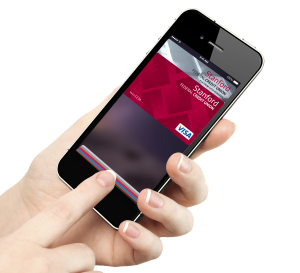
At Stanford FCU, we’re always looking ahead to the future. Our community is driven by a progressive spirit—and you’re our next generation of forward thinkers. Student Checking at Stanford FCU puts your needs first. We provide personal care, and quality electronic and mobile services—without the service charges—to allow you to bank anytime that’s convenient for you, get organized and stay on track, while working on your degree.


Mobile Wallets are no longer the wave of the future. They’re an everyday payment option.
Get started today:
Enjoy all the benefits of your Stanford FCU Visa debit or credit cards using Mobile Wallets.
| Checking Basics |
Stanford FCU Student Checking |
Bank of America Core Checking |
Wells Fargo Everyday Checking® |
|---|---|---|---|
| Monthly Fee | NONE | $121 | $101 |
| Overdraft Protection Transfer | FREE Unlimited2 | $12 per day3 | $12.50 per transfer4 |
| ATMs on Campus | 20 | 1 | 4 |
| Using Other Bank’s ATMs | 4 FREE per month | $2.50 EACH transaction + Surcharge Fee or $5 outside U.S. + Surcharge Fee | $2.50 EACH transaction + Surcharge Fee or $5 outside U.S. + Surcharge Fee |
| Fee-FREE ATMs | 30,000 | 16,000 | 13,000 |
| Instant Issue Visa Debit Card | YES – this is your permanent card | No | YES (temporary for 30 days) |
| Branches on Campus | 3 | None | 1 |
| Send money from your checking account to just about anyone (or receive it) |
YES | YES | YES |
| Incoming Domestic Wire Fee | NONE | $15 | $15 |
| Incoming International Wire Fee | NONE | $16 | $16 |
| Debit & Credit Card Foreign Transaction Fee |
NONE5 | 3% of U.S. amount | 3% of U.S. amount |
| Opening Deposit | None6 | $25 | $25 |
| Overdraft & NSF Fees | $20 | $35 | $35 |
| Stop Payment Fee | $20 | $30 | $31 |
We don’t believe you should have to pay extra just to use basic banking services. We have the checking account that fits your lifestyle without any hidden fees, allowing you to do more and bank less.
| Below Minimum Fee | NONE | Non-Sufficient Funds (ACH or Check) |
$20 |
|---|---|---|---|
| Debit Card Foreign Transaction Fee |
NONE | Overdraft Protection (ACH or Check) |
$20 |
| Incoming Wire Fee (Domestic and International) |
NONE | Stop Payment Fee | $20 |
| Overdraft Protection Transfer Fee |
NONE | Outgoing Domestic Wire Fee |
$10 |
| ATM Access Charge for Non-Stanford FCU ATM |
NONE | Outgoing International Wire Fee |
$20 |
| Inactivity/Dormant Fee (12 consecutive months of inactivity) |
$5 |
Here are the most common questions we receive from International students wanting to learn more about Stanford FCU:
A credit union is created by a particular population to serve that particular population. For example, IBM has its own credit union, Hewlett Packard has its own credit union and Stanford University has Stanford FCU. Our members (known as customers in banks) are our owners. Credit unions are not-for-profit, so any profit we make, after operating expenses, goes directly back to the members in the form of lower rates on loans, higher rates on savings and low or no-fee financial services. Banks do not require affiliations to companies or organizations. They serve the general population, their main purpose is to make money and their profit is paid directly to their shareholders.
Comparison information as obtained January 2018 via respective bank websites, and bank disclosures. Information is subject to change.
1 Fee waived when specific criteria are met or you are under 24 years old and enrolled in school.
2 Transfer from Stanford FCU Savings. Overdraft protection also available from Stanford FCU Line of Credit or Stanford FCU Visa®.
3 Overdraft protection from a linked savings account or line of credit.
4 Transfer from a linked WFB savings account. Overdraft protection also available from a Wells Fargo Visa.
5 SFCU does not charge foreign transaction fees on Debit and Credit Card Transactions, but other financial institutions or merchants may.
6 All members are required to have a $5 membership share balance in any of the following accounts: Checking Account, Savings Account, Money Market Account, Share Certificate or Individual Retirement Account.
Note: Please refer to the Truth in Savings Disclosures and Truth in Lending Disclosures of the respective financial institutions for additional details.